Strategic Analysis of Unilever: Business Strategy Report (Unit 32)
VerifiedAdded on 2023/01/16
|16
|5354
|64
Report
AI Summary
This report provides a comprehensive analysis of Unilever's business strategy, focusing on the impact of the macro environment using PESTLE analysis, including political, economic, social, technological, environmental, and legal factors. It further examines Unilever's internal environment and organizational capabilities using the McKinsey 7-S model and VRIO analysis to assess its strengths and weaknesses. The report also applies Porter's Five Forces model to evaluate the competitive landscape and proposes strategies for improving competitiveness. Finally, it synthesizes these analyses to formulate a strategic management plan, offering insights into Unilever's long-term objectives and strategic direction. The analysis highlights the interplay of external factors, internal capabilities, and competitive dynamics in shaping Unilever's strategic decisions and overall performance within the global market.
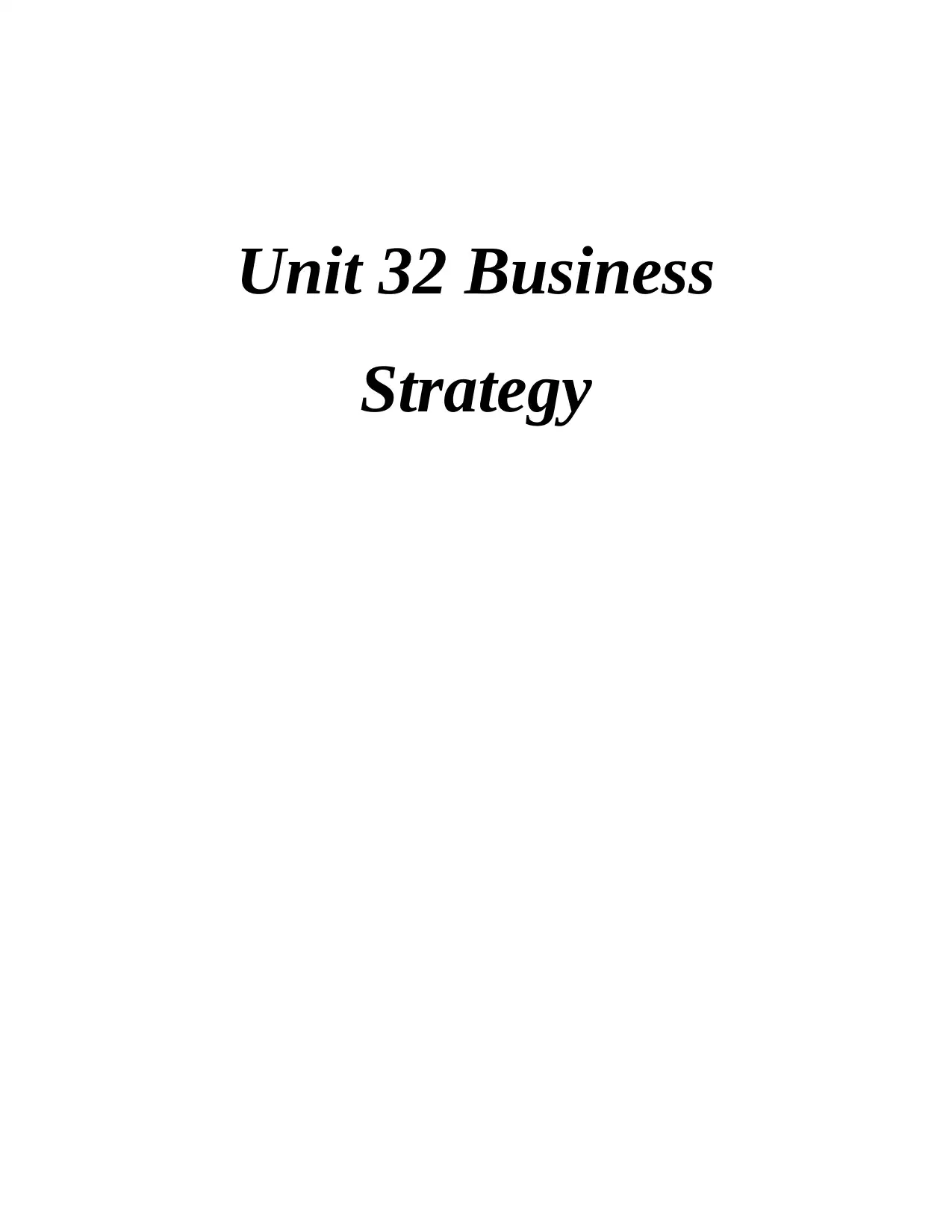
Unit 32 Business
Strategy
Strategy
Paraphrase This Document
Need a fresh take? Get an instant paraphrase of this document with our AI Paraphraser
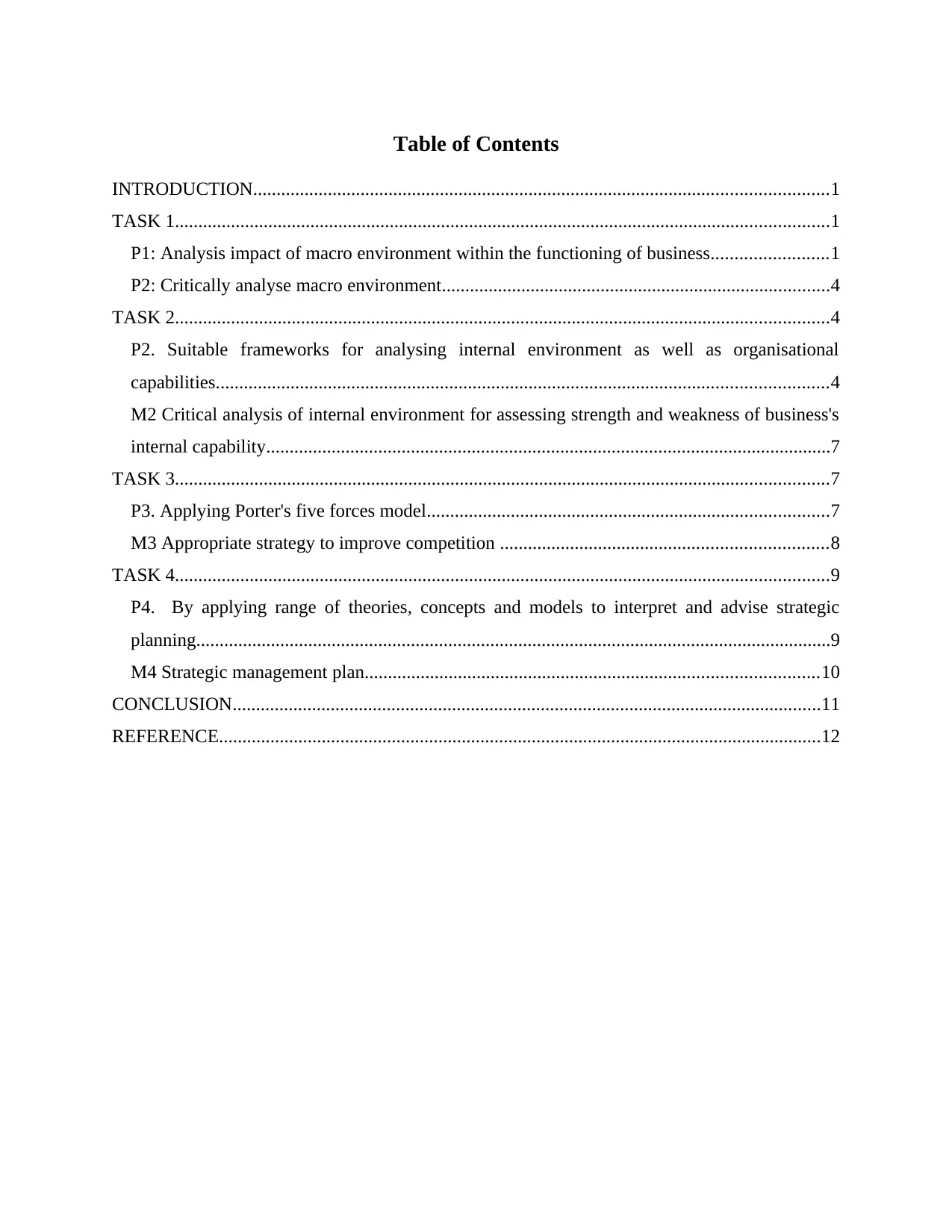
Table of Contents
INTRODUCTION...........................................................................................................................1
TASK 1............................................................................................................................................1
P1: Analysis impact of macro environment within the functioning of business.........................1
P2: Critically analyse macro environment...................................................................................4
TASK 2............................................................................................................................................4
P2. Suitable frameworks for analysing internal environment as well as organisational
capabilities...................................................................................................................................4
M2 Critical analysis of internal environment for assessing strength and weakness of business's
internal capability.........................................................................................................................7
TASK 3............................................................................................................................................7
P3. Applying Porter's five forces model......................................................................................7
M3 Appropriate strategy to improve competition ......................................................................8
TASK 4............................................................................................................................................9
P4. By applying range of theories, concepts and models to interpret and advise strategic
planning........................................................................................................................................9
M4 Strategic management plan.................................................................................................10
CONCLUSION..............................................................................................................................11
REFERENCE.................................................................................................................................12
INTRODUCTION...........................................................................................................................1
TASK 1............................................................................................................................................1
P1: Analysis impact of macro environment within the functioning of business.........................1
P2: Critically analyse macro environment...................................................................................4
TASK 2............................................................................................................................................4
P2. Suitable frameworks for analysing internal environment as well as organisational
capabilities...................................................................................................................................4
M2 Critical analysis of internal environment for assessing strength and weakness of business's
internal capability.........................................................................................................................7
TASK 3............................................................................................................................................7
P3. Applying Porter's five forces model......................................................................................7
M3 Appropriate strategy to improve competition ......................................................................8
TASK 4............................................................................................................................................9
P4. By applying range of theories, concepts and models to interpret and advise strategic
planning........................................................................................................................................9
M4 Strategic management plan.................................................................................................10
CONCLUSION..............................................................................................................................11
REFERENCE.................................................................................................................................12
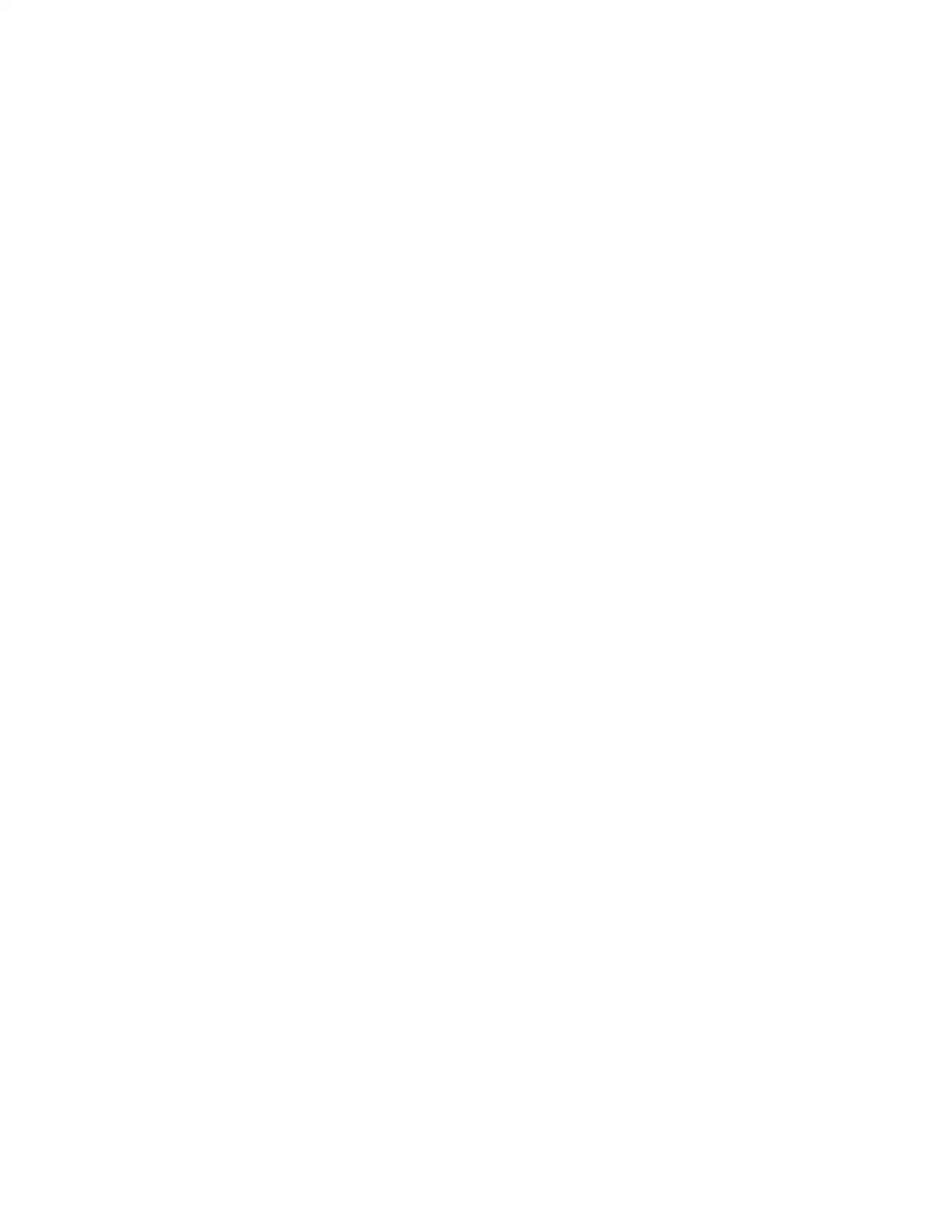
⊘ This is a preview!⊘
Do you want full access?
Subscribe today to unlock all pages.

Trusted by 1+ million students worldwide
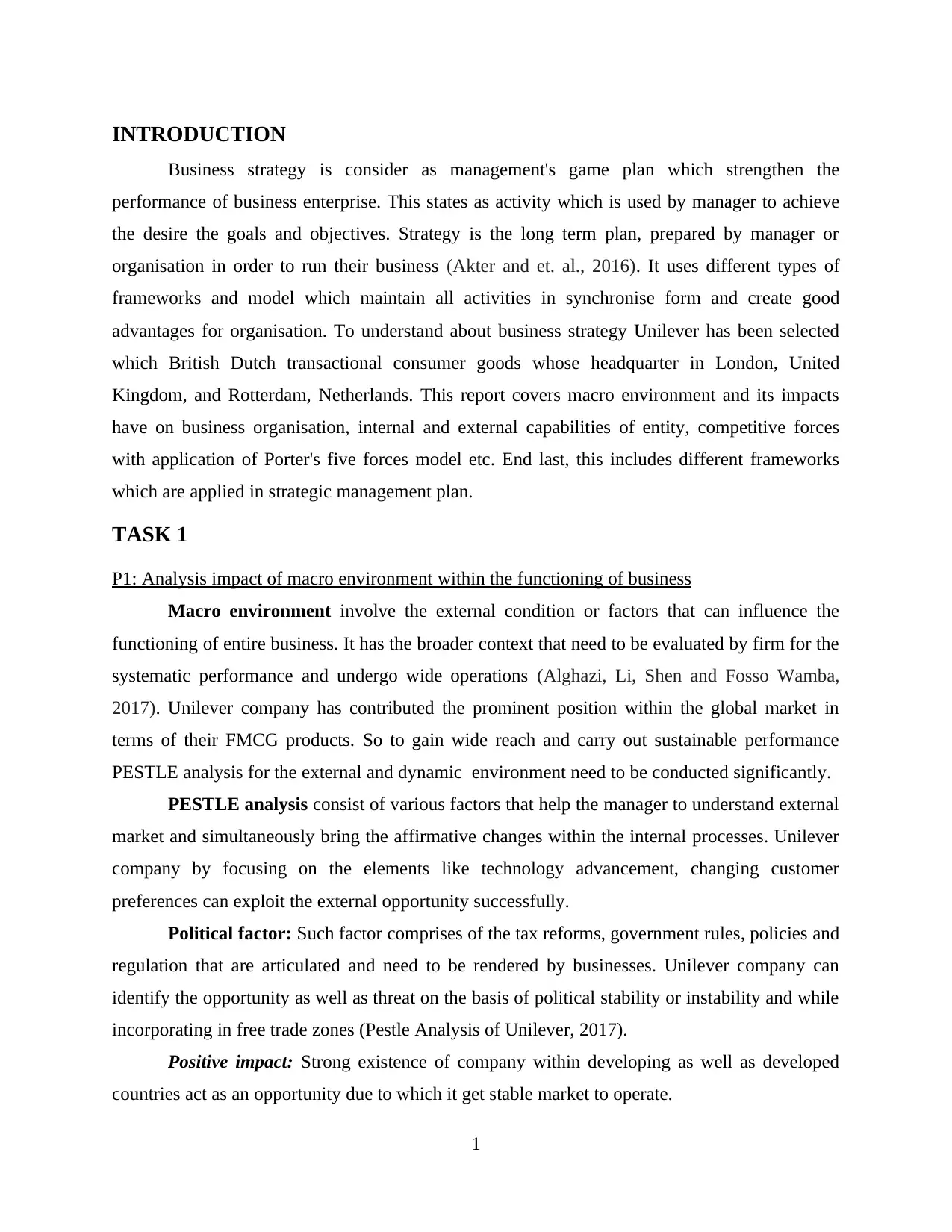
INTRODUCTION
Business strategy is consider as management's game plan which strengthen the
performance of business enterprise. This states as activity which is used by manager to achieve
the desire the goals and objectives. Strategy is the long term plan, prepared by manager or
organisation in order to run their business (Akter and et. al., 2016). It uses different types of
frameworks and model which maintain all activities in synchronise form and create good
advantages for organisation. To understand about business strategy Unilever has been selected
which British Dutch transactional consumer goods whose headquarter in London, United
Kingdom, and Rotterdam, Netherlands. This report covers macro environment and its impacts
have on business organisation, internal and external capabilities of entity, competitive forces
with application of Porter's five forces model etc. End last, this includes different frameworks
which are applied in strategic management plan.
TASK 1
P1: Analysis impact of macro environment within the functioning of business
Macro environment involve the external condition or factors that can influence the
functioning of entire business. It has the broader context that need to be evaluated by firm for the
systematic performance and undergo wide operations (Alghazi, Li, Shen and Fosso Wamba,
2017). Unilever company has contributed the prominent position within the global market in
terms of their FMCG products. So to gain wide reach and carry out sustainable performance
PESTLE analysis for the external and dynamic environment need to be conducted significantly.
PESTLE analysis consist of various factors that help the manager to understand external
market and simultaneously bring the affirmative changes within the internal processes. Unilever
company by focusing on the elements like technology advancement, changing customer
preferences can exploit the external opportunity successfully.
Political factor: Such factor comprises of the tax reforms, government rules, policies and
regulation that are articulated and need to be rendered by businesses. Unilever company can
identify the opportunity as well as threat on the basis of political stability or instability and while
incorporating in free trade zones (Pestle Analysis of Unilever, 2017).
Positive impact: Strong existence of company within developing as well as developed
countries act as an opportunity due to which it get stable market to operate.
1
Business strategy is consider as management's game plan which strengthen the
performance of business enterprise. This states as activity which is used by manager to achieve
the desire the goals and objectives. Strategy is the long term plan, prepared by manager or
organisation in order to run their business (Akter and et. al., 2016). It uses different types of
frameworks and model which maintain all activities in synchronise form and create good
advantages for organisation. To understand about business strategy Unilever has been selected
which British Dutch transactional consumer goods whose headquarter in London, United
Kingdom, and Rotterdam, Netherlands. This report covers macro environment and its impacts
have on business organisation, internal and external capabilities of entity, competitive forces
with application of Porter's five forces model etc. End last, this includes different frameworks
which are applied in strategic management plan.
TASK 1
P1: Analysis impact of macro environment within the functioning of business
Macro environment involve the external condition or factors that can influence the
functioning of entire business. It has the broader context that need to be evaluated by firm for the
systematic performance and undergo wide operations (Alghazi, Li, Shen and Fosso Wamba,
2017). Unilever company has contributed the prominent position within the global market in
terms of their FMCG products. So to gain wide reach and carry out sustainable performance
PESTLE analysis for the external and dynamic environment need to be conducted significantly.
PESTLE analysis consist of various factors that help the manager to understand external
market and simultaneously bring the affirmative changes within the internal processes. Unilever
company by focusing on the elements like technology advancement, changing customer
preferences can exploit the external opportunity successfully.
Political factor: Such factor comprises of the tax reforms, government rules, policies and
regulation that are articulated and need to be rendered by businesses. Unilever company can
identify the opportunity as well as threat on the basis of political stability or instability and while
incorporating in free trade zones (Pestle Analysis of Unilever, 2017).
Positive impact: Strong existence of company within developing as well as developed
countries act as an opportunity due to which it get stable market to operate.
1
Paraphrase This Document
Need a fresh take? Get an instant paraphrase of this document with our AI Paraphraser
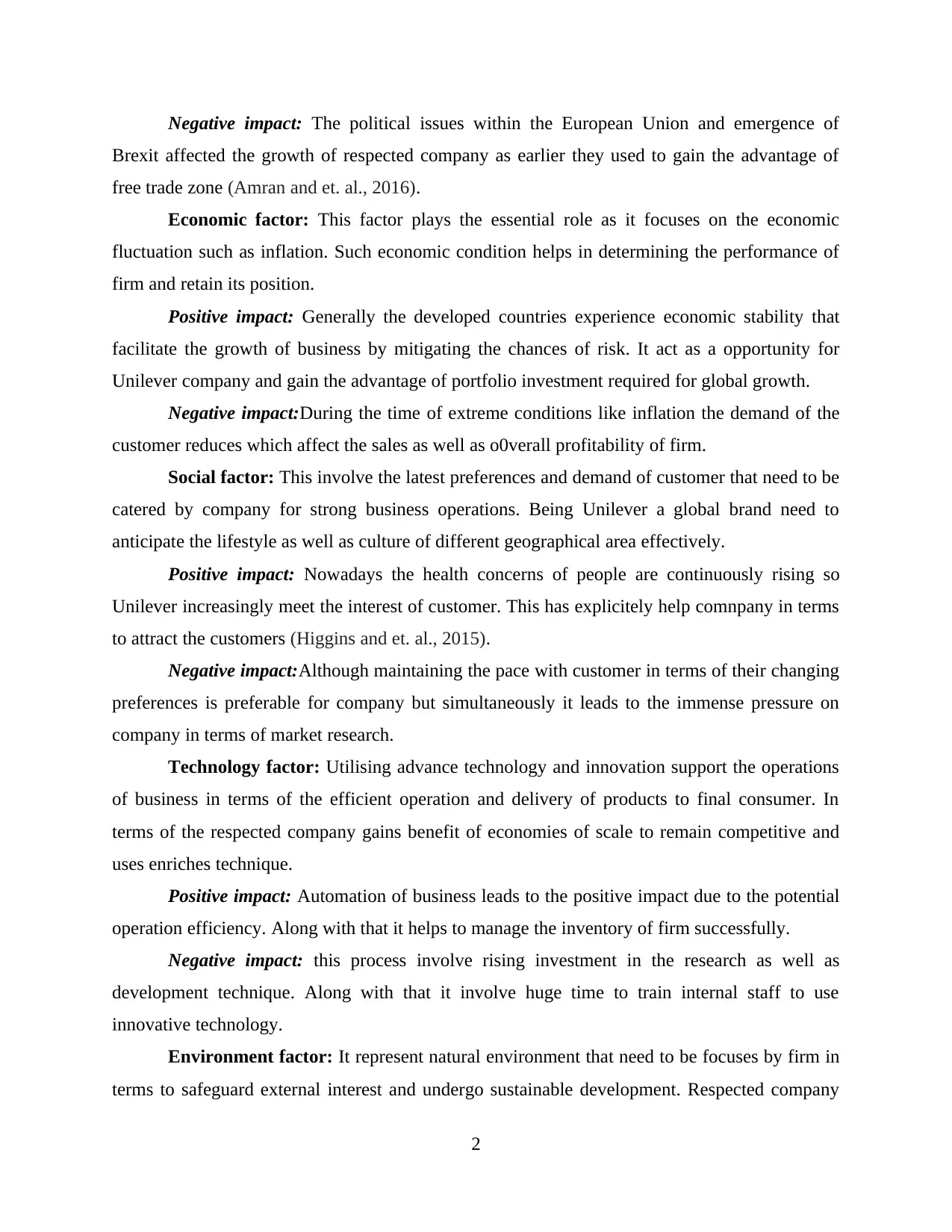
Negative impact: The political issues within the European Union and emergence of
Brexit affected the growth of respected company as earlier they used to gain the advantage of
free trade zone (Amran and et. al., 2016).
Economic factor: This factor plays the essential role as it focuses on the economic
fluctuation such as inflation. Such economic condition helps in determining the performance of
firm and retain its position.
Positive impact: Generally the developed countries experience economic stability that
facilitate the growth of business by mitigating the chances of risk. It act as a opportunity for
Unilever company and gain the advantage of portfolio investment required for global growth.
Negative impact:During the time of extreme conditions like inflation the demand of the
customer reduces which affect the sales as well as o0verall profitability of firm.
Social factor: This involve the latest preferences and demand of customer that need to be
catered by company for strong business operations. Being Unilever a global brand need to
anticipate the lifestyle as well as culture of different geographical area effectively.
Positive impact: Nowadays the health concerns of people are continuously rising so
Unilever increasingly meet the interest of customer. This has explicitely help comnpany in terms
to attract the customers (Higgins and et. al., 2015).
Negative impact:Although maintaining the pace with customer in terms of their changing
preferences is preferable for company but simultaneously it leads to the immense pressure on
company in terms of market research.
Technology factor: Utilising advance technology and innovation support the operations
of business in terms of the efficient operation and delivery of products to final consumer. In
terms of the respected company gains benefit of economies of scale to remain competitive and
uses enriches technique.
Positive impact: Automation of business leads to the positive impact due to the potential
operation efficiency. Along with that it helps to manage the inventory of firm successfully.
Negative impact: this process involve rising investment in the research as well as
development technique. Along with that it involve huge time to train internal staff to use
innovative technology.
Environment factor: It represent natural environment that need to be focuses by firm in
terms to safeguard external interest and undergo sustainable development. Respected company
2
Brexit affected the growth of respected company as earlier they used to gain the advantage of
free trade zone (Amran and et. al., 2016).
Economic factor: This factor plays the essential role as it focuses on the economic
fluctuation such as inflation. Such economic condition helps in determining the performance of
firm and retain its position.
Positive impact: Generally the developed countries experience economic stability that
facilitate the growth of business by mitigating the chances of risk. It act as a opportunity for
Unilever company and gain the advantage of portfolio investment required for global growth.
Negative impact:During the time of extreme conditions like inflation the demand of the
customer reduces which affect the sales as well as o0verall profitability of firm.
Social factor: This involve the latest preferences and demand of customer that need to be
catered by company for strong business operations. Being Unilever a global brand need to
anticipate the lifestyle as well as culture of different geographical area effectively.
Positive impact: Nowadays the health concerns of people are continuously rising so
Unilever increasingly meet the interest of customer. This has explicitely help comnpany in terms
to attract the customers (Higgins and et. al., 2015).
Negative impact:Although maintaining the pace with customer in terms of their changing
preferences is preferable for company but simultaneously it leads to the immense pressure on
company in terms of market research.
Technology factor: Utilising advance technology and innovation support the operations
of business in terms of the efficient operation and delivery of products to final consumer. In
terms of the respected company gains benefit of economies of scale to remain competitive and
uses enriches technique.
Positive impact: Automation of business leads to the positive impact due to the potential
operation efficiency. Along with that it helps to manage the inventory of firm successfully.
Negative impact: this process involve rising investment in the research as well as
development technique. Along with that it involve huge time to train internal staff to use
innovative technology.
Environment factor: It represent natural environment that need to be focuses by firm in
terms to safeguard external interest and undergo sustainable development. Respected company
2
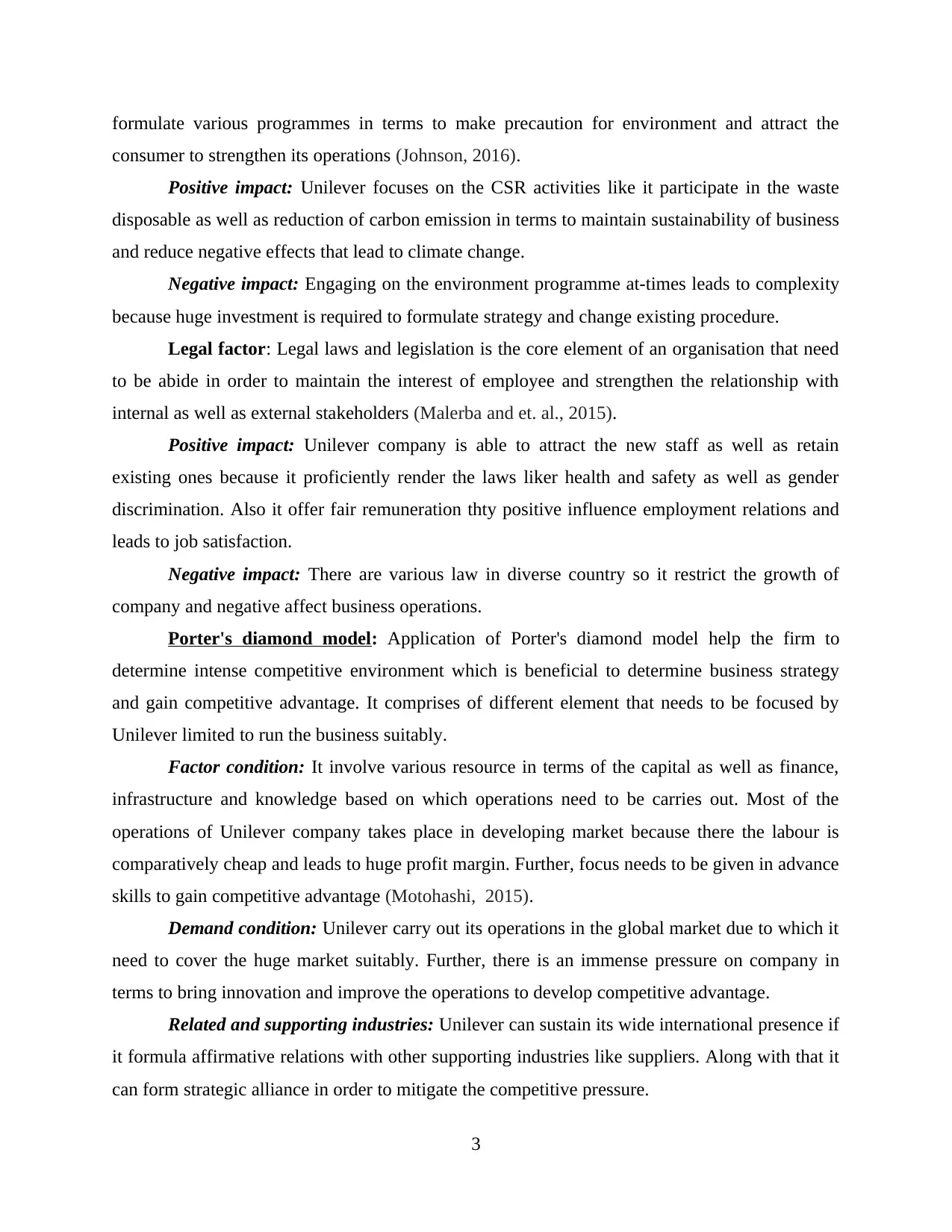
formulate various programmes in terms to make precaution for environment and attract the
consumer to strengthen its operations (Johnson, 2016).
Positive impact: Unilever focuses on the CSR activities like it participate in the waste
disposable as well as reduction of carbon emission in terms to maintain sustainability of business
and reduce negative effects that lead to climate change.
Negative impact: Engaging on the environment programme at-times leads to complexity
because huge investment is required to formulate strategy and change existing procedure.
Legal factor: Legal laws and legislation is the core element of an organisation that need
to be abide in order to maintain the interest of employee and strengthen the relationship with
internal as well as external stakeholders (Malerba and et. al., 2015).
Positive impact: Unilever company is able to attract the new staff as well as retain
existing ones because it proficiently render the laws liker health and safety as well as gender
discrimination. Also it offer fair remuneration thty positive influence employment relations and
leads to job satisfaction.
Negative impact: There are various law in diverse country so it restrict the growth of
company and negative affect business operations.
Porter's diamond model: Application of Porter's diamond model help the firm to
determine intense competitive environment which is beneficial to determine business strategy
and gain competitive advantage. It comprises of different element that needs to be focused by
Unilever limited to run the business suitably.
Factor condition: It involve various resource in terms of the capital as well as finance,
infrastructure and knowledge based on which operations need to be carries out. Most of the
operations of Unilever company takes place in developing market because there the labour is
comparatively cheap and leads to huge profit margin. Further, focus needs to be given in advance
skills to gain competitive advantage (Motohashi, 2015).
Demand condition: Unilever carry out its operations in the global market due to which it
need to cover the huge market suitably. Further, there is an immense pressure on company in
terms to bring innovation and improve the operations to develop competitive advantage.
Related and supporting industries: Unilever can sustain its wide international presence if
it formula affirmative relations with other supporting industries like suppliers. Along with that it
can form strategic alliance in order to mitigate the competitive pressure.
3
consumer to strengthen its operations (Johnson, 2016).
Positive impact: Unilever focuses on the CSR activities like it participate in the waste
disposable as well as reduction of carbon emission in terms to maintain sustainability of business
and reduce negative effects that lead to climate change.
Negative impact: Engaging on the environment programme at-times leads to complexity
because huge investment is required to formulate strategy and change existing procedure.
Legal factor: Legal laws and legislation is the core element of an organisation that need
to be abide in order to maintain the interest of employee and strengthen the relationship with
internal as well as external stakeholders (Malerba and et. al., 2015).
Positive impact: Unilever company is able to attract the new staff as well as retain
existing ones because it proficiently render the laws liker health and safety as well as gender
discrimination. Also it offer fair remuneration thty positive influence employment relations and
leads to job satisfaction.
Negative impact: There are various law in diverse country so it restrict the growth of
company and negative affect business operations.
Porter's diamond model: Application of Porter's diamond model help the firm to
determine intense competitive environment which is beneficial to determine business strategy
and gain competitive advantage. It comprises of different element that needs to be focused by
Unilever limited to run the business suitably.
Factor condition: It involve various resource in terms of the capital as well as finance,
infrastructure and knowledge based on which operations need to be carries out. Most of the
operations of Unilever company takes place in developing market because there the labour is
comparatively cheap and leads to huge profit margin. Further, focus needs to be given in advance
skills to gain competitive advantage (Motohashi, 2015).
Demand condition: Unilever carry out its operations in the global market due to which it
need to cover the huge market suitably. Further, there is an immense pressure on company in
terms to bring innovation and improve the operations to develop competitive advantage.
Related and supporting industries: Unilever can sustain its wide international presence if
it formula affirmative relations with other supporting industries like suppliers. Along with that it
can form strategic alliance in order to mitigate the competitive pressure.
3
⊘ This is a preview!⊘
Do you want full access?
Subscribe today to unlock all pages.

Trusted by 1+ million students worldwide
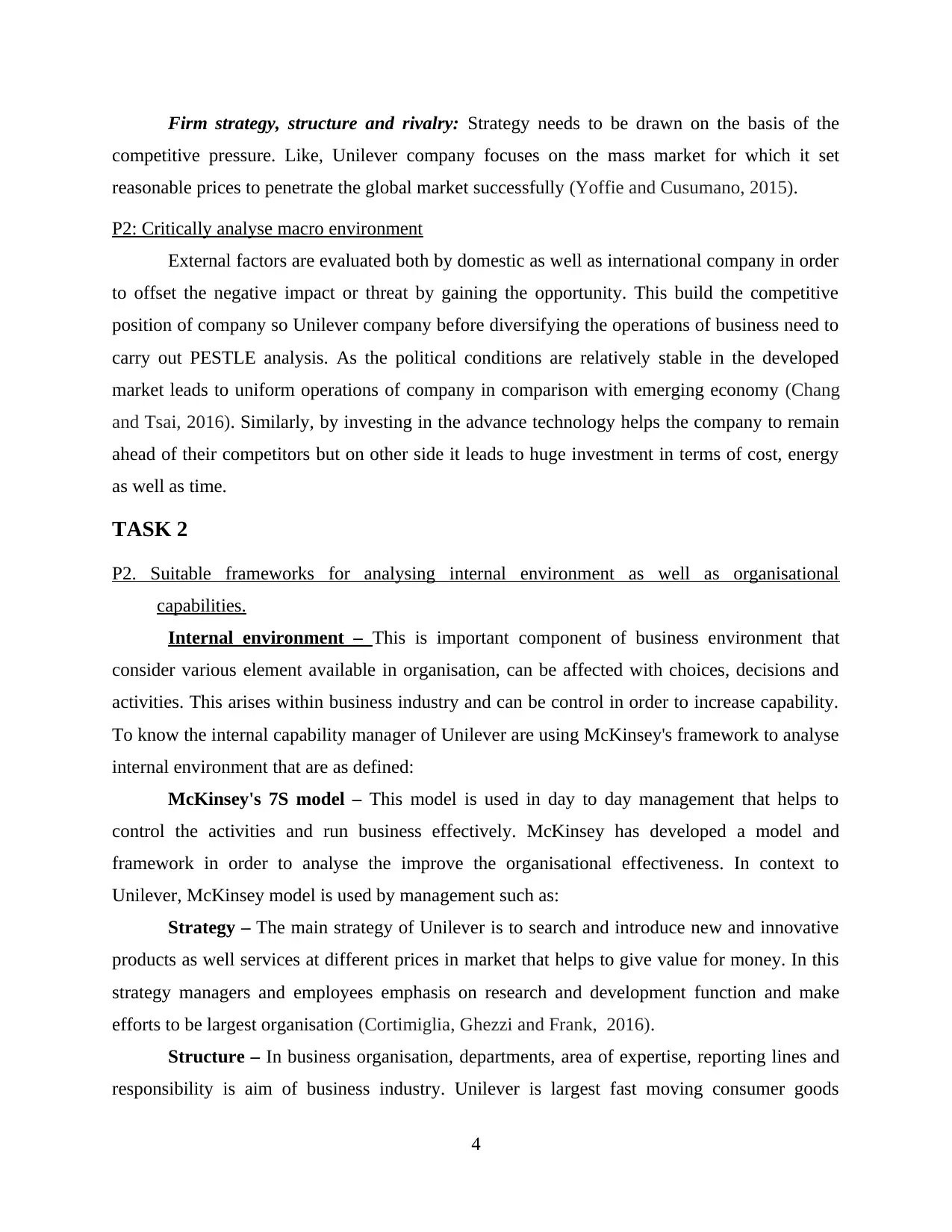
Firm strategy, structure and rivalry: Strategy needs to be drawn on the basis of the
competitive pressure. Like, Unilever company focuses on the mass market for which it set
reasonable prices to penetrate the global market successfully (Yoffie and Cusumano, 2015).
P2: Critically analyse macro environment
External factors are evaluated both by domestic as well as international company in order
to offset the negative impact or threat by gaining the opportunity. This build the competitive
position of company so Unilever company before diversifying the operations of business need to
carry out PESTLE analysis. As the political conditions are relatively stable in the developed
market leads to uniform operations of company in comparison with emerging economy (Chang
and Tsai, 2016). Similarly, by investing in the advance technology helps the company to remain
ahead of their competitors but on other side it leads to huge investment in terms of cost, energy
as well as time.
TASK 2
P2. Suitable frameworks for analysing internal environment as well as organisational
capabilities.
Internal environment – This is important component of business environment that
consider various element available in organisation, can be affected with choices, decisions and
activities. This arises within business industry and can be control in order to increase capability.
To know the internal capability manager of Unilever are using McKinsey's framework to analyse
internal environment that are as defined:
McKinsey's 7S model – This model is used in day to day management that helps to
control the activities and run business effectively. McKinsey has developed a model and
framework in order to analyse the improve the organisational effectiveness. In context to
Unilever, McKinsey model is used by management such as:
Strategy – The main strategy of Unilever is to search and introduce new and innovative
products as well services at different prices in market that helps to give value for money. In this
strategy managers and employees emphasis on research and development function and make
efforts to be largest organisation (Cortimiglia, Ghezzi and Frank, 2016).
Structure – In business organisation, departments, area of expertise, reporting lines and
responsibility is aim of business industry. Unilever is largest fast moving consumer goods
4
competitive pressure. Like, Unilever company focuses on the mass market for which it set
reasonable prices to penetrate the global market successfully (Yoffie and Cusumano, 2015).
P2: Critically analyse macro environment
External factors are evaluated both by domestic as well as international company in order
to offset the negative impact or threat by gaining the opportunity. This build the competitive
position of company so Unilever company before diversifying the operations of business need to
carry out PESTLE analysis. As the political conditions are relatively stable in the developed
market leads to uniform operations of company in comparison with emerging economy (Chang
and Tsai, 2016). Similarly, by investing in the advance technology helps the company to remain
ahead of their competitors but on other side it leads to huge investment in terms of cost, energy
as well as time.
TASK 2
P2. Suitable frameworks for analysing internal environment as well as organisational
capabilities.
Internal environment – This is important component of business environment that
consider various element available in organisation, can be affected with choices, decisions and
activities. This arises within business industry and can be control in order to increase capability.
To know the internal capability manager of Unilever are using McKinsey's framework to analyse
internal environment that are as defined:
McKinsey's 7S model – This model is used in day to day management that helps to
control the activities and run business effectively. McKinsey has developed a model and
framework in order to analyse the improve the organisational effectiveness. In context to
Unilever, McKinsey model is used by management such as:
Strategy – The main strategy of Unilever is to search and introduce new and innovative
products as well services at different prices in market that helps to give value for money. In this
strategy managers and employees emphasis on research and development function and make
efforts to be largest organisation (Cortimiglia, Ghezzi and Frank, 2016).
Structure – In business organisation, departments, area of expertise, reporting lines and
responsibility is aim of business industry. Unilever is largest fast moving consumer goods
4
Paraphrase This Document
Need a fresh take? Get an instant paraphrase of this document with our AI Paraphraser
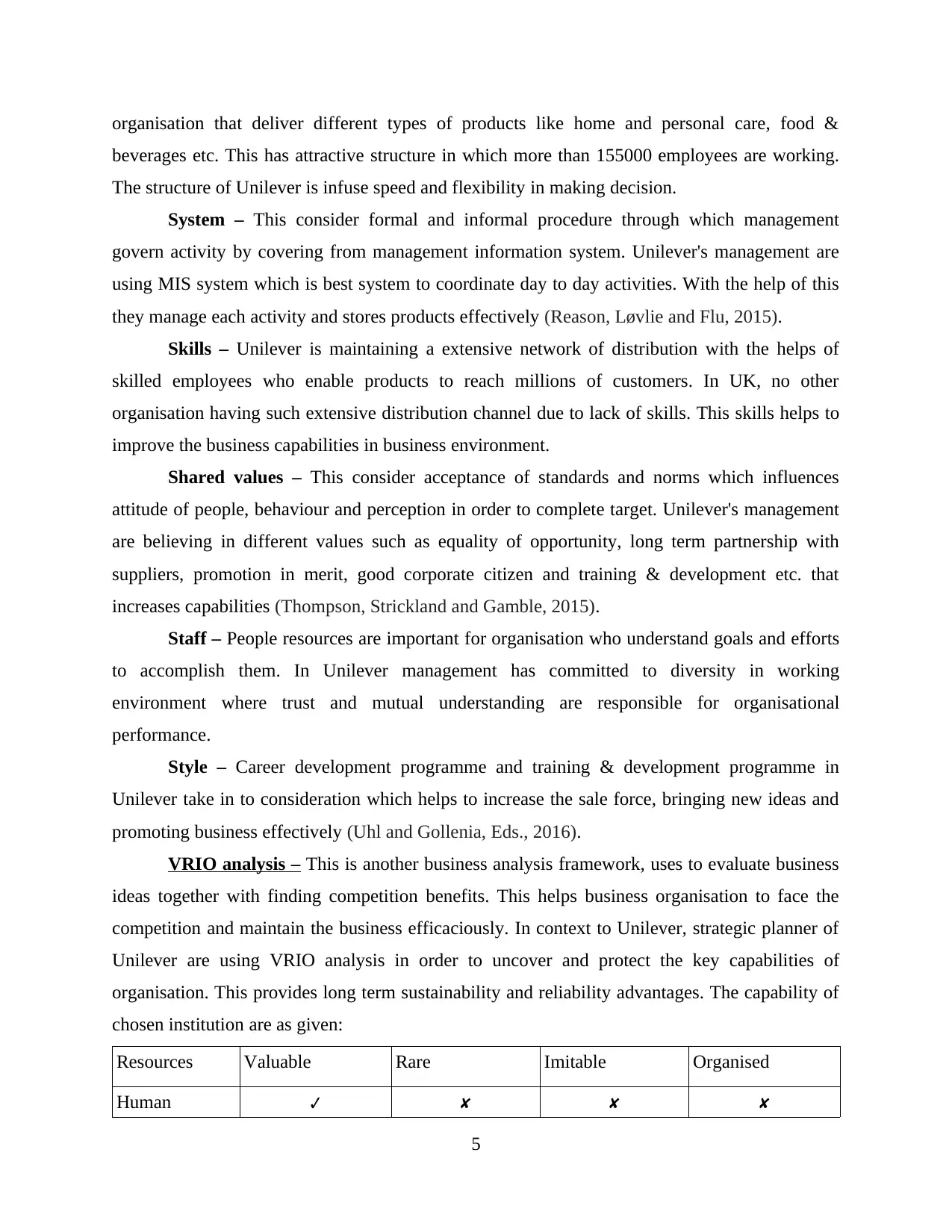
organisation that deliver different types of products like home and personal care, food &
beverages etc. This has attractive structure in which more than 155000 employees are working.
The structure of Unilever is infuse speed and flexibility in making decision.
System – This consider formal and informal procedure through which management
govern activity by covering from management information system. Unilever's management are
using MIS system which is best system to coordinate day to day activities. With the help of this
they manage each activity and stores products effectively (Reason, Løvlie and Flu, 2015).
Skills – Unilever is maintaining a extensive network of distribution with the helps of
skilled employees who enable products to reach millions of customers. In UK, no other
organisation having such extensive distribution channel due to lack of skills. This skills helps to
improve the business capabilities in business environment.
Shared values – This consider acceptance of standards and norms which influences
attitude of people, behaviour and perception in order to complete target. Unilever's management
are believing in different values such as equality of opportunity, long term partnership with
suppliers, promotion in merit, good corporate citizen and training & development etc. that
increases capabilities (Thompson, Strickland and Gamble, 2015).
Staff – People resources are important for organisation who understand goals and efforts
to accomplish them. In Unilever management has committed to diversity in working
environment where trust and mutual understanding are responsible for organisational
performance.
Style – Career development programme and training & development programme in
Unilever take in to consideration which helps to increase the sale force, bringing new ideas and
promoting business effectively (Uhl and Gollenia, Eds., 2016).
VRIO analysis – This is another business analysis framework, uses to evaluate business
ideas together with finding competition benefits. This helps business organisation to face the
competition and maintain the business efficaciously. In context to Unilever, strategic planner of
Unilever are using VRIO analysis in order to uncover and protect the key capabilities of
organisation. This provides long term sustainability and reliability advantages. The capability of
chosen institution are as given:
Resources Valuable Rare Imitable Organised
Human ✔ ✘ ✘ ✘
5
beverages etc. This has attractive structure in which more than 155000 employees are working.
The structure of Unilever is infuse speed and flexibility in making decision.
System – This consider formal and informal procedure through which management
govern activity by covering from management information system. Unilever's management are
using MIS system which is best system to coordinate day to day activities. With the help of this
they manage each activity and stores products effectively (Reason, Løvlie and Flu, 2015).
Skills – Unilever is maintaining a extensive network of distribution with the helps of
skilled employees who enable products to reach millions of customers. In UK, no other
organisation having such extensive distribution channel due to lack of skills. This skills helps to
improve the business capabilities in business environment.
Shared values – This consider acceptance of standards and norms which influences
attitude of people, behaviour and perception in order to complete target. Unilever's management
are believing in different values such as equality of opportunity, long term partnership with
suppliers, promotion in merit, good corporate citizen and training & development etc. that
increases capabilities (Thompson, Strickland and Gamble, 2015).
Staff – People resources are important for organisation who understand goals and efforts
to accomplish them. In Unilever management has committed to diversity in working
environment where trust and mutual understanding are responsible for organisational
performance.
Style – Career development programme and training & development programme in
Unilever take in to consideration which helps to increase the sale force, bringing new ideas and
promoting business effectively (Uhl and Gollenia, Eds., 2016).
VRIO analysis – This is another business analysis framework, uses to evaluate business
ideas together with finding competition benefits. This helps business organisation to face the
competition and maintain the business efficaciously. In context to Unilever, strategic planner of
Unilever are using VRIO analysis in order to uncover and protect the key capabilities of
organisation. This provides long term sustainability and reliability advantages. The capability of
chosen institution are as given:
Resources Valuable Rare Imitable Organised
Human ✔ ✘ ✘ ✘
5
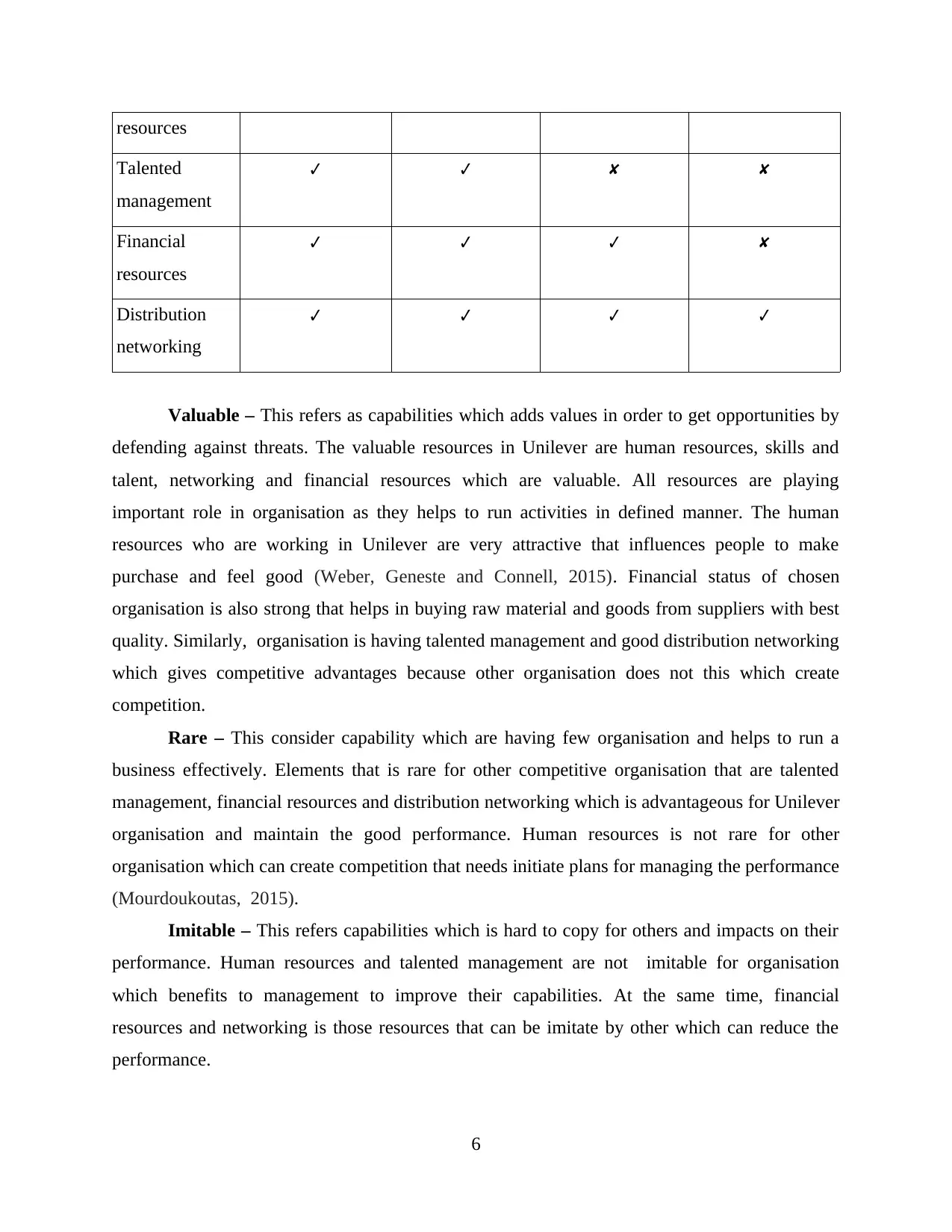
resources
Talented
management
✔ ✔ ✘ ✘
Financial
resources
✔ ✔ ✔ ✘
Distribution
networking
✔ ✔ ✔ ✔
Valuable – This refers as capabilities which adds values in order to get opportunities by
defending against threats. The valuable resources in Unilever are human resources, skills and
talent, networking and financial resources which are valuable. All resources are playing
important role in organisation as they helps to run activities in defined manner. The human
resources who are working in Unilever are very attractive that influences people to make
purchase and feel good (Weber, Geneste and Connell, 2015). Financial status of chosen
organisation is also strong that helps in buying raw material and goods from suppliers with best
quality. Similarly, organisation is having talented management and good distribution networking
which gives competitive advantages because other organisation does not this which create
competition.
Rare – This consider capability which are having few organisation and helps to run a
business effectively. Elements that is rare for other competitive organisation that are talented
management, financial resources and distribution networking which is advantageous for Unilever
organisation and maintain the good performance. Human resources is not rare for other
organisation which can create competition that needs initiate plans for managing the performance
(Mourdoukoutas, 2015).
Imitable – This refers capabilities which is hard to copy for others and impacts on their
performance. Human resources and talented management are not imitable for organisation
which benefits to management to improve their capabilities. At the same time, financial
resources and networking is those resources that can be imitate by other which can reduce the
performance.
6
Talented
management
✔ ✔ ✘ ✘
Financial
resources
✔ ✔ ✔ ✘
Distribution
networking
✔ ✔ ✔ ✔
Valuable – This refers as capabilities which adds values in order to get opportunities by
defending against threats. The valuable resources in Unilever are human resources, skills and
talent, networking and financial resources which are valuable. All resources are playing
important role in organisation as they helps to run activities in defined manner. The human
resources who are working in Unilever are very attractive that influences people to make
purchase and feel good (Weber, Geneste and Connell, 2015). Financial status of chosen
organisation is also strong that helps in buying raw material and goods from suppliers with best
quality. Similarly, organisation is having talented management and good distribution networking
which gives competitive advantages because other organisation does not this which create
competition.
Rare – This consider capability which are having few organisation and helps to run a
business effectively. Elements that is rare for other competitive organisation that are talented
management, financial resources and distribution networking which is advantageous for Unilever
organisation and maintain the good performance. Human resources is not rare for other
organisation which can create competition that needs initiate plans for managing the performance
(Mourdoukoutas, 2015).
Imitable – This refers capabilities which is hard to copy for others and impacts on their
performance. Human resources and talented management are not imitable for organisation
which benefits to management to improve their capabilities. At the same time, financial
resources and networking is those resources that can be imitate by other which can reduce the
performance.
6
⊘ This is a preview!⊘
Do you want full access?
Subscribe today to unlock all pages.

Trusted by 1+ million students worldwide
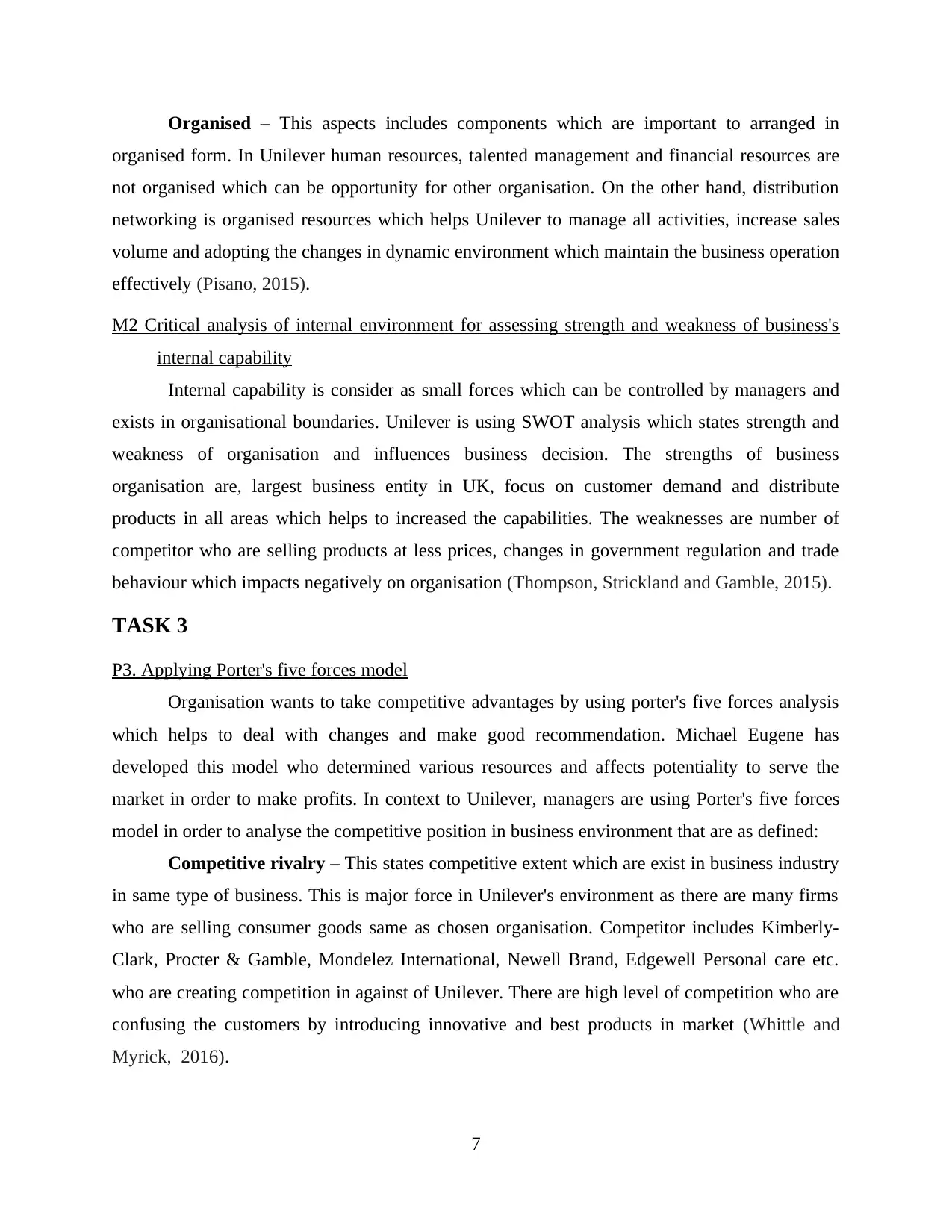
Organised – This aspects includes components which are important to arranged in
organised form. In Unilever human resources, talented management and financial resources are
not organised which can be opportunity for other organisation. On the other hand, distribution
networking is organised resources which helps Unilever to manage all activities, increase sales
volume and adopting the changes in dynamic environment which maintain the business operation
effectively (Pisano, 2015).
M2 Critical analysis of internal environment for assessing strength and weakness of business's
internal capability
Internal capability is consider as small forces which can be controlled by managers and
exists in organisational boundaries. Unilever is using SWOT analysis which states strength and
weakness of organisation and influences business decision. The strengths of business
organisation are, largest business entity in UK, focus on customer demand and distribute
products in all areas which helps to increased the capabilities. The weaknesses are number of
competitor who are selling products at less prices, changes in government regulation and trade
behaviour which impacts negatively on organisation (Thompson, Strickland and Gamble, 2015).
TASK 3
P3. Applying Porter's five forces model
Organisation wants to take competitive advantages by using porter's five forces analysis
which helps to deal with changes and make good recommendation. Michael Eugene has
developed this model who determined various resources and affects potentiality to serve the
market in order to make profits. In context to Unilever, managers are using Porter's five forces
model in order to analyse the competitive position in business environment that are as defined:
Competitive rivalry – This states competitive extent which are exist in business industry
in same type of business. This is major force in Unilever's environment as there are many firms
who are selling consumer goods same as chosen organisation. Competitor includes Kimberly-
Clark, Procter & Gamble, Mondelez International, Newell Brand, Edgewell Personal care etc.
who are creating competition in against of Unilever. There are high level of competition who are
confusing the customers by introducing innovative and best products in market (Whittle and
Myrick, 2016).
7
organised form. In Unilever human resources, talented management and financial resources are
not organised which can be opportunity for other organisation. On the other hand, distribution
networking is organised resources which helps Unilever to manage all activities, increase sales
volume and adopting the changes in dynamic environment which maintain the business operation
effectively (Pisano, 2015).
M2 Critical analysis of internal environment for assessing strength and weakness of business's
internal capability
Internal capability is consider as small forces which can be controlled by managers and
exists in organisational boundaries. Unilever is using SWOT analysis which states strength and
weakness of organisation and influences business decision. The strengths of business
organisation are, largest business entity in UK, focus on customer demand and distribute
products in all areas which helps to increased the capabilities. The weaknesses are number of
competitor who are selling products at less prices, changes in government regulation and trade
behaviour which impacts negatively on organisation (Thompson, Strickland and Gamble, 2015).
TASK 3
P3. Applying Porter's five forces model
Organisation wants to take competitive advantages by using porter's five forces analysis
which helps to deal with changes and make good recommendation. Michael Eugene has
developed this model who determined various resources and affects potentiality to serve the
market in order to make profits. In context to Unilever, managers are using Porter's five forces
model in order to analyse the competitive position in business environment that are as defined:
Competitive rivalry – This states competitive extent which are exist in business industry
in same type of business. This is major force in Unilever's environment as there are many firms
who are selling consumer goods same as chosen organisation. Competitor includes Kimberly-
Clark, Procter & Gamble, Mondelez International, Newell Brand, Edgewell Personal care etc.
who are creating competition in against of Unilever. There are high level of competition who are
confusing the customers by introducing innovative and best products in market (Whittle and
Myrick, 2016).
7
Paraphrase This Document
Need a fresh take? Get an instant paraphrase of this document with our AI Paraphraser
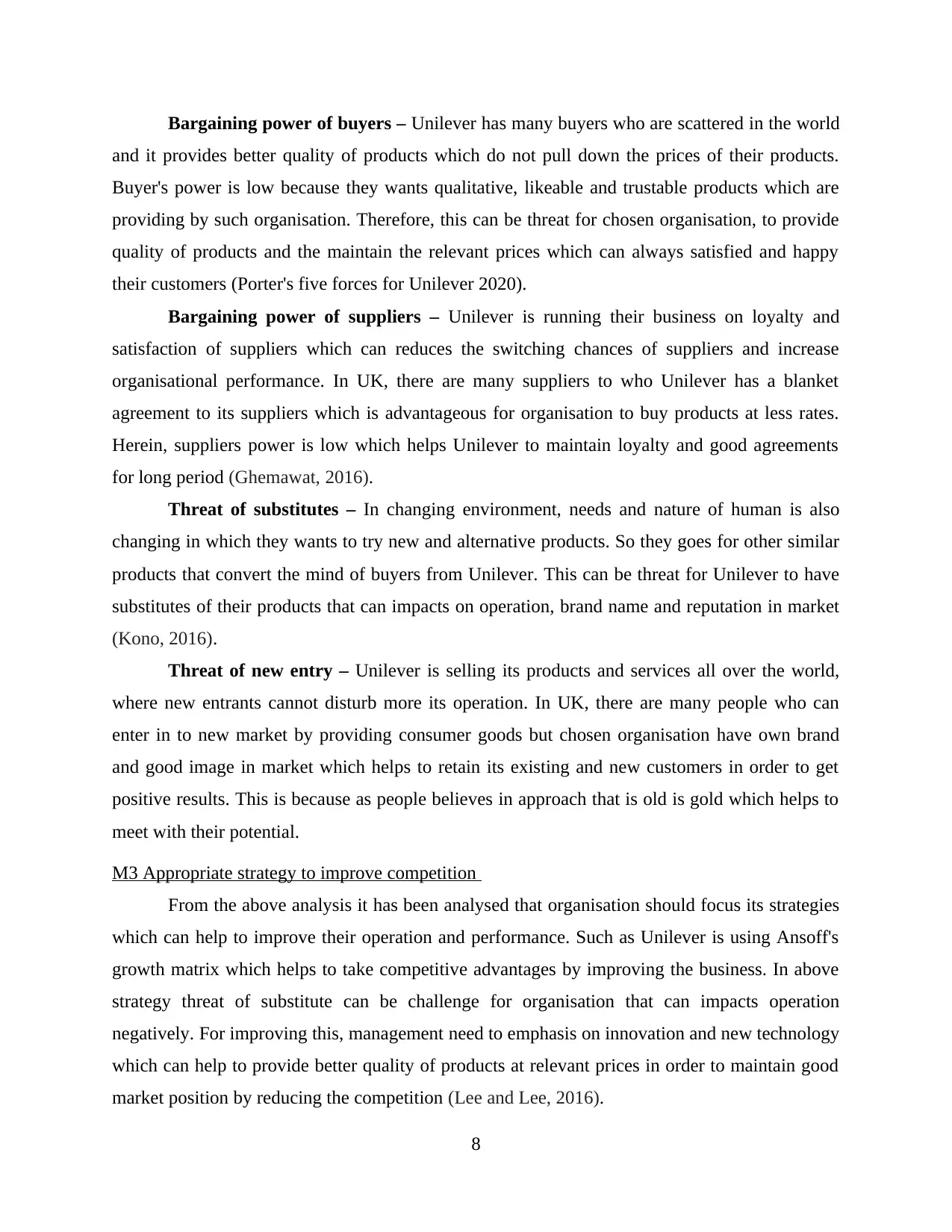
Bargaining power of buyers – Unilever has many buyers who are scattered in the world
and it provides better quality of products which do not pull down the prices of their products.
Buyer's power is low because they wants qualitative, likeable and trustable products which are
providing by such organisation. Therefore, this can be threat for chosen organisation, to provide
quality of products and the maintain the relevant prices which can always satisfied and happy
their customers (Porter's five forces for Unilever 2020).
Bargaining power of suppliers – Unilever is running their business on loyalty and
satisfaction of suppliers which can reduces the switching chances of suppliers and increase
organisational performance. In UK, there are many suppliers to who Unilever has a blanket
agreement to its suppliers which is advantageous for organisation to buy products at less rates.
Herein, suppliers power is low which helps Unilever to maintain loyalty and good agreements
for long period (Ghemawat, 2016).
Threat of substitutes – In changing environment, needs and nature of human is also
changing in which they wants to try new and alternative products. So they goes for other similar
products that convert the mind of buyers from Unilever. This can be threat for Unilever to have
substitutes of their products that can impacts on operation, brand name and reputation in market
(Kono, 2016).
Threat of new entry – Unilever is selling its products and services all over the world,
where new entrants cannot disturb more its operation. In UK, there are many people who can
enter in to new market by providing consumer goods but chosen organisation have own brand
and good image in market which helps to retain its existing and new customers in order to get
positive results. This is because as people believes in approach that is old is gold which helps to
meet with their potential.
M3 Appropriate strategy to improve competition
From the above analysis it has been analysed that organisation should focus its strategies
which can help to improve their operation and performance. Such as Unilever is using Ansoff's
growth matrix which helps to take competitive advantages by improving the business. In above
strategy threat of substitute can be challenge for organisation that can impacts operation
negatively. For improving this, management need to emphasis on innovation and new technology
which can help to provide better quality of products at relevant prices in order to maintain good
market position by reducing the competition (Lee and Lee, 2016).
8
and it provides better quality of products which do not pull down the prices of their products.
Buyer's power is low because they wants qualitative, likeable and trustable products which are
providing by such organisation. Therefore, this can be threat for chosen organisation, to provide
quality of products and the maintain the relevant prices which can always satisfied and happy
their customers (Porter's five forces for Unilever 2020).
Bargaining power of suppliers – Unilever is running their business on loyalty and
satisfaction of suppliers which can reduces the switching chances of suppliers and increase
organisational performance. In UK, there are many suppliers to who Unilever has a blanket
agreement to its suppliers which is advantageous for organisation to buy products at less rates.
Herein, suppliers power is low which helps Unilever to maintain loyalty and good agreements
for long period (Ghemawat, 2016).
Threat of substitutes – In changing environment, needs and nature of human is also
changing in which they wants to try new and alternative products. So they goes for other similar
products that convert the mind of buyers from Unilever. This can be threat for Unilever to have
substitutes of their products that can impacts on operation, brand name and reputation in market
(Kono, 2016).
Threat of new entry – Unilever is selling its products and services all over the world,
where new entrants cannot disturb more its operation. In UK, there are many people who can
enter in to new market by providing consumer goods but chosen organisation have own brand
and good image in market which helps to retain its existing and new customers in order to get
positive results. This is because as people believes in approach that is old is gold which helps to
meet with their potential.
M3 Appropriate strategy to improve competition
From the above analysis it has been analysed that organisation should focus its strategies
which can help to improve their operation and performance. Such as Unilever is using Ansoff's
growth matrix which helps to take competitive advantages by improving the business. In above
strategy threat of substitute can be challenge for organisation that can impacts operation
negatively. For improving this, management need to emphasis on innovation and new technology
which can help to provide better quality of products at relevant prices in order to maintain good
market position by reducing the competition (Lee and Lee, 2016).
8

TASK 4
P4. By applying range of theories, concepts and models to interpret and advise strategic
planning
Strategic planning is the activity and process of business organisation that is used to make
right business decision by distributing the resources and pursue action plan. In other words, it is
planning process which is done by Unilever organisation to make growth and development and
enhance the productivity (Macarthy, 2018). In context to Unilever, management are using Ansoff
Matrix which is strategic planning and helps in growth and development that are as defined:
Ansoff Matrix
This is growth and development model, developed by Igor Ansoff in 1957 to make
improvement in business industry. This model helps Unilever to analyse the risk of their business
and focus on continuous growth that are as following:
Market Penetration – This consider as first development strategy which is used to
develop the business. In this, management of business organisation focuses on growth and
development of business by offering its existing products in existing market. In context to
Unilever, management can use this strategy by providing existing products and services in
existing market by making some improvement and also uses promotional strategy which helps to
get customer's attention in order to growth as well as development of business. Such strategy is
less risky because existing products are sold in to already established marketplace (Orna, 2017).
Product development – This is crucial for organisation to improve their business by
using this strategy because in this organisation need to introduce new product and services in
existing market that can attract customers. The management of Unilever can grow and develop
their business by launching new products in existing market that can fulfil customer's needs and
wants. With the help of this sale volume can be increase, customer base and market share also
can be capture in high share which grows the business.
Market development – This is another growth strategy, in which management make
development and growth of business by expansion of business activities in another area and
market. Unilever can grow its business by operation activities in other country and market place
that can help to attract customers and encourages them to make purchase. This is risky strategy
than others because it is not clear for organisation what products customer wants and make
business expansion (Burlton, 2015).
9
P4. By applying range of theories, concepts and models to interpret and advise strategic
planning
Strategic planning is the activity and process of business organisation that is used to make
right business decision by distributing the resources and pursue action plan. In other words, it is
planning process which is done by Unilever organisation to make growth and development and
enhance the productivity (Macarthy, 2018). In context to Unilever, management are using Ansoff
Matrix which is strategic planning and helps in growth and development that are as defined:
Ansoff Matrix
This is growth and development model, developed by Igor Ansoff in 1957 to make
improvement in business industry. This model helps Unilever to analyse the risk of their business
and focus on continuous growth that are as following:
Market Penetration – This consider as first development strategy which is used to
develop the business. In this, management of business organisation focuses on growth and
development of business by offering its existing products in existing market. In context to
Unilever, management can use this strategy by providing existing products and services in
existing market by making some improvement and also uses promotional strategy which helps to
get customer's attention in order to growth as well as development of business. Such strategy is
less risky because existing products are sold in to already established marketplace (Orna, 2017).
Product development – This is crucial for organisation to improve their business by
using this strategy because in this organisation need to introduce new product and services in
existing market that can attract customers. The management of Unilever can grow and develop
their business by launching new products in existing market that can fulfil customer's needs and
wants. With the help of this sale volume can be increase, customer base and market share also
can be capture in high share which grows the business.
Market development – This is another growth strategy, in which management make
development and growth of business by expansion of business activities in another area and
market. Unilever can grow its business by operation activities in other country and market place
that can help to attract customers and encourages them to make purchase. This is risky strategy
than others because it is not clear for organisation what products customer wants and make
business expansion (Burlton, 2015).
9
⊘ This is a preview!⊘
Do you want full access?
Subscribe today to unlock all pages.

Trusted by 1+ million students worldwide
1 out of 16
Related Documents
Your All-in-One AI-Powered Toolkit for Academic Success.
+13062052269
info@desklib.com
Available 24*7 on WhatsApp / Email
![[object Object]](/_next/static/media/star-bottom.7253800d.svg)
Unlock your academic potential
Copyright © 2020–2025 A2Z Services. All Rights Reserved. Developed and managed by ZUCOL.




